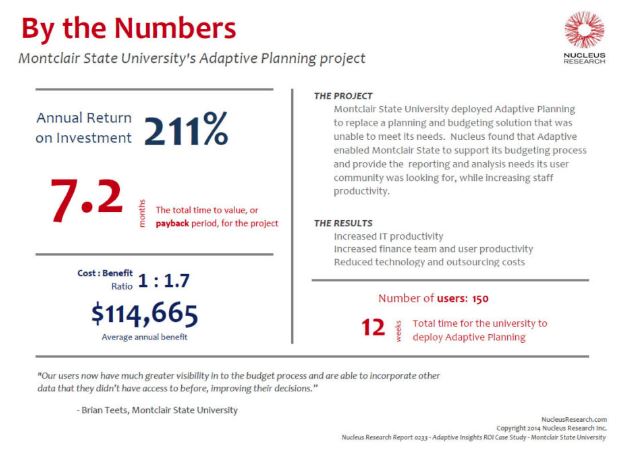3 Key Functions of a Modern CPM Solution
Outcomes are important for any Finance organization. There are many means to the end in working within the Office of Finance. Working with the right people to implement the plan and monitor the plan is one method. Building up processes to keep the focus on the right activities is another. The tools utilized to support people and the processes is another important factor. All three create the means to the end for the team.
In this article, I will expand upon that notion and discuss a class of tools commonly used to drive a modern FP&A function, directly supporting the budgeting, planning, and reporting functions of an organization. These tools are referred to commonly as: EPM (Enterprise Performance Management), BPM (Business Performance Management), or CPM (Corporate Performance Management). Whatever you want to call it (I’ll choose CPM), a well-designed CPM tool is a key part of the overall Office of Finance function that goes beyond ERP systems to support a robust implementation of strategy.
The 3 key features of a modern CPM tool are:
- Functionality
- Reporting & Dashboards
- Systems Integration
Every CPM platform will bring with it a set of functions and capabilities. The process of comparing potential solutions based on functionality can be simplified and streamlined by taking the time to predetermine your organization’s “must have” requirements.
After you evaluate your existing processes and business needs, you will be able to better prioritize key needs from a CPM solution and translate your strategy into an actionable plan.
Functionality
Our experienced team of consultants has seen certain functionality proven to be the most popular and most valuable as part of determining the CPM tool.
Easy & Flexible
- More flexible modeling capabilities: Multidimensional and simple to use, enabling cross-departmental buy-in for new budgeting techniques – such as driver-based planning and rolling forecasts – is essential. Supports scenario planning and what-if analysis to model key potential changes in the business.
- Ease-of-use: Simple and intuitive technology that reduces the amount of training and installation work. Systems should be owned by finance departments and be easily manageable.
- Decentralized Decision Making & Planning: Allows the ability to engage many users in the budgeting and planning process. The right tool contains mechanisms to tag activities with strategic categorization and workflow approval mechanism of budgets.
Powerful & Fast
- Calculating speed and accuracy: A good, fast calculation engine is essential. Particularly, a CPM solution should have an in-memory computing platform designed for large scale multi-dimensional modeling, reporting, and analysis. An application that enables granular, unlimited and complex planning and reporting by any number of critical business dimensions (customer, channel, product, regions, rep, etc.) by day, week, or other time period, or unlimited planning scenarios.
- Faster Time to Value: Intuitive interface and drag-and-drop modeling and reporting interface to help organizations implement their new planning environment quickly and achieve value sooner. A rapid implementation cycle reduces project risk and frees teams to develop more sophisticated models.
Reporting & Dashboards
Empowering insights in the hands of the Office of Finance leverages actionable and timely insights. Experience matters when creating scalable account and metadata structures.
- Drill Down and Roll-up Capacity: Ability to drill down to underlying source systems when analyzing results.
- Robust Self-Service Reporting: The flexibility to query data in many different ways and marry into the functionality of different formats such as Excel. Supports the use of narratives to get to the reason of variances.
- Dashboards: Integration with the planning and financial reporting functions. Seamless drill into data and easy and intuitive display of data.
Systems Integration
Your modern CPM solution should be the central data outlet driving timely decisions with updated data. This includes financial and non-financial data sources.
- Connectivity and Collaboration: Easy integration with other corporate systems are an essential component of an effective FP&A system.
- ERP Agnostic: Seamlessly integrate with ERP, CRM, HCM and BI systems, whether that be financial or non-financial data.
- Planning Integration: Double entry is good for accounting, not Finance. Enter a modeled amount once and see the immediate impact to P&L, Cash Flow and Balance Sheet.
These all may sound like great ideas to modern FP&A function, but how painful is the process of transformation?
In my experience in a former role as an end user of a CPM solution, I know there is a light at the end of the tunnel. Montclair State University suffered from the same financial planning challenges that most other organizations are facing today. In the end, through the deployment of a modern CPM solution and robust planning processes, there was a real bottom line impact. A ROI case by Nucleus Research captured a 211% ROI and payback in 7.2 months. The planning cycle was also reduced and the project was deployed in 12 weeks.¹

Break free of static planning with an active planning process enabled by a modern CPM solution. One that is collaborative, comprehensive, and continuous; one that results in a better business plan. You’ll get greater visibility into business performance, build confidence in the numbers, make data-derived decisions, and increase buy-in and accountability throughout the organization.
References
1 “Adaptive Insights ROI Case Study: Montclair State University.” Nucleus Research | Return On Investment (ROI), Nucleus Research, Nov. 2014, nucleusresearch.com/research/single/adaptive-insights-roi-case-study-montclair-state-university/.
About Ironside
Ironside was founded in 1999 as an enterprise data and analytics solution provider and system integrator. Our clients hire us to acquire, enrich and measure their data so they can make smarter, better decisions about their business. No matter your industry or specific business challenges, Ironside has the experience, perspective and agility to help transform your analytic environment.






